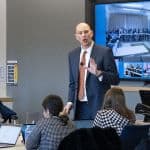Learning is an Afterthought at Most Donor-Funded Programs: Here’s How to Make it a Priority
Learning within donor-funded programs tends to be an afterthought, despite the millions of dollars funders spend every year on various “learning activities” like research, monitoring, evaluation and learning (MEL), and dissemination activities. Why? Because those programs are built for implementation rather than knowledge creation. More often than not, operational, programmatic and strategic decisions are driven by the necessity to reach ambitious outreach and impact targets, hit disbursement quotas and achieve program milestones.
Given the scale of the challenges the development sector is trying to address, it’s not surprising that the emphasis is on achieving these ambitious goals – but we believe that this shouldn’t come at the expense of setting up robust learning systems. In fact, we argue that being intentional about learning is a prerequisite for any program to truly reach its potential, in terms of performance and impact.
Learning is core to what the Mastercard Foundation Rural & Agricultural Finance Learning Lab (the Lab) does. Our mandate is to support learning within the Mastercard Foundation’s US $180 million+ smallholder finance portfolio, to shift perceptions about smallholders, and to crowd more investment into a sector that is facing a $170 billion financing gap. This is no small feat, and having good learning systems is critical to achieving it.
That’s why, in 2016, we launched an initiative to collect insights from our partners. Our approach involved reviewing partner documents and interviewing each partner to understand the key lessons learned from their programs. While this exercise yielded some useful insights for the Lab team, the most important lesson we learned was that it did not generate significant value to our partners. Many found the process onerous, and once the aggregated insights were shared back to partners, too much time had elapsed for them to be actionable.
It was clear that we had to rethink the approach entirely.
Based on feedback from our partners, we developed a new, partner-led approach to learning – a process whereby we provide them with support to improve their own capacity to capture, analyze and synthesize insights internally. We worked closely with Dalberg Design to design and pilot solutions, and those solutions were compiled in our Dynamic Learning Playbook. And while the partners we work with are concentrated in the rural and agricultural finance sector, these solutions can be adapted for any context or industry.
A Partner-Focused Approach to Learning from Donor-Funded Programs
While every organization’s learning needs and challenges are different, we take a simple three-step approach to supporting our partners in building out a more robust and intentional approach to learning. These are steps that any organization can take to improve their learning systems.
Step 1: How does learning currently happen within an organization?
The first step is to conduct a deep dive, to understand how learning currently happens and to identify pain points or gaps. In most cases, this deep dive is conducted via individual one-on-one interviews with members across a team or organization. Sometimes we also run an interactive workshop with everyone in the same room, working through a series of open-ended questions that help us collectively map information and knowledge flows.
We also use a Knowledge Flow Mapping tool, which helps create a common understanding of what types of information and knowledge are produced by different functions or teams, and how that is shared internally. The output from this step is an “insights report,” which summarizes the key findings from the deep dive: We review and iterate on this report with each partner, to make sure the conclusions reached accurately reflect their reality.
Step 2: How might learning be improved?
Working with each partner, we select opportunity areas to focus on, which act as a starting point for the development of solutions. Our ‘How might we…?’ ideation activity tool reframes the organization’s challenges into opportunities to design solutions, and sets the group up for creative or lateral thinking.
Step 3: How can changes be implemented?
We use a simple road-mapping template, such as the one included in the “How might we…” ideation activity toolkit. To date, we’ve worked with a number of our partners to design, adapt and implement simple tools to facilitate changes in their approach to learning, most of which are compiled in our Dynamic Learning Playbook.
Through working with a diverse set of partners, we’ve found that one of the most versatile tools in our Playbook is the Insights Capture Tool, which allows users across an organization to collaboratively capture and organize real-time insights as they emerge. For instance, our partner Root Capital uses this tool to capture what they’re learning from business owners who attend their trainings, while the Mastercard Foundation’s Fund for Rural Prosperity uses it to capture insights from progress reports and site visits. Taking a lightweight but systematic approach to capturing and structuring qualitative insights is an easy way to embed learning into your team’s daily workflows.
What Have we Learned About Partner-Led Learning Approaches?
It’s been almost a full year since we’ve launched the Dynamic Learning Playbook. We’ve successfully implemented the approach outlined above with several partners, but it hasn’t necessarily been easy to bring all of them on board, despite this partner-led learning approach being designed on the basis of their feedback. There are two main reasons for this. Firstly, we started working on this initiative when our partners were already several years into implementing their programs, which means that a certain way of working had already set in. Secondly, donor budgets are earmarked for specific activities, leaving little room for our partners to build their organizational learning capacity.
For any funders considering how to improve their approach to learning with their portfolio partners, here are a few things to keep in mind:
- Learning must be an intentional practice. In order for an organization to be effective at learning, some level of structure is needed. However, learning doesn’t need to be complex or expensive: We developed the Dynamic Learning Playbook to help organizations we work with find right-sized, simple and adaptable solutions.
- Learning systems must be tailored to the needs and requirements of an organization’s learning culture. We try to avoid, as much as possible, creating new processes and new sets of responsibilities in the name of learning. Instead, we’ve found that we can achieve good results by going with the grain of how the partner organization already works. We repurpose existing ways of working to bring out learning more clearly – a model that seems to make these changes easier to adopt. Our most enthusiastic partners on this initiative span the full spectrum of organizational typologies: a bank, impact investors, a market facilitator, an NGO and a fund manager. This confirms that our approach to learning is truly adaptive and applicable to any type of organization.
- Learning processes should be deeply embedded throughout implementation activities, rather than be a separate activity at the end of the project lifecycle. Learning often takes a backseat to implementation in the first phase of an initiative or program. This means that organizational systems and processes may not be designed for learning, but rather for tracking outreach targets and compliance. There’s an assumption that because nothing “happens” in the first year or so of implementation, no learnings are being generated. It becomes challenging to shift from an implementation-first to a learning mindset once a certain culture has been established.
- Building a learning organization requires flexible funding to support day-to-day learning. There’s a misconception that because budget is allocated to MEL activities, learning is happening automatically. In actuality, learning is a dynamic activity meant to help everyone within a team or organization continually assess and improve the way they work. It is not the sole responsibility of the MEL team. Learning occurs at multiple levels, is influenced by culture and context, and happens in formal and informal ways. Ultimately, becoming intentional about learning requires striking a balance between hard systems and soft processes. And being able to strike that balance depends on funders providing their partner with the resources they need to cover day-to-day learning, in addition to budgeting for the usual MEL activities.
It will take both time and effort to change the status quo in donor-funded projects. But by focusing on building a culture of learning, both organizations and their funders will benefit, generating invaluable knowledge that can make their own future projects more effective – while also helping like-minded organizations identify best practices and avoid pitfalls. Considering the daunting challenges the development sector is tackling, this new focus could make the difference between success and failure.
Anne Maftei is the Learning Manager at the Mastercard Foundation Rural & Agricultural Finance Learning Lab.
Photo courtesy of USAID.
- Categories
- Impact Assessment




